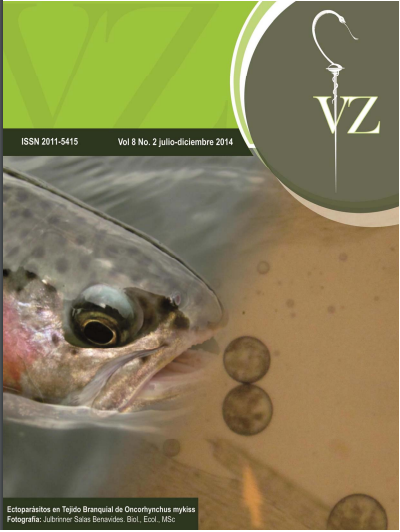Autores/as
Resumen
RESUMEN: El estudio de las crisis epilépticas en caninos es relevante en investigación, ya que son un modelo natural de epilepsia, como en clínica de pequeños animales, debido a su alta frecuencia en el atendimiento neurológico. Este trabajo adaptó el apéndice “Fenomenología ictal. Glosario de Terminología Ictal Descriptiva” en la clínica de pacientes caninos con crisis epiléptica para clasificar su fenomenología y reconocer una zona sintomatogénica. El análisis de la fenomenología y la zona sintomatogénica sugieren que caninos con crisis epiléptica presentan áreas cerebrales sensibles de generar actividad neuronal anormal, específicamente; la alta frecuencia del grupo fenomenológico Motor definió una localización en el lóbulo parietal-frontal.
Palabras clave
Citas
Berendt, M.; Gram, L. Epilepsy and seizure classification in 63 dogs: Areappraisal of veterinary epilepsy terminology. J. Vet Intern Med., v.13, n.1, p.14‐20, 1999.
Berendt, M.;Gredal, H.;Alving, J. Characteristic and phenomenology of epileptic partial seizures in dogs: Similarities with human seizure semiology. pilepsy Research., v. 61, p. 167‐173, 2004.
Berg, A.T.; Berkovic, S.F.; Brodie, M.J.; Buchhalter, J.; Cross, J.H.; Van Emde, B.W. et al. Revised terminology and concepts for organization of seizures and epilepsies: Report of the ILAE Commission on Classification and Terminology, 2005‐2009. Epilepsia, v.51, n.4, p. 676‐85, 2010.
Blume‐Chair, W.T.;Luders, H.O.; Mizrahi, E. et al. Glossary of descriptive terminology for Ictal Semiology: Report of the ILAE Task Force on Classification and Terminology. ILAE Commission Report. Epilepsia, v.42, n.9, p. 1212‐1218, 2001.
Commision on Classification and Terminology of the International LeagueAgainst Epilepsy. Proposal for revised classification of epilepsies and epileptic syndromes. Epilepsia, v.2, p. 389‐399, 1989.
Commission on Classification and Terminology of the International League Against Epilepsy. Proposal for revised clinical and electroencephalographic classification of epileptic seizures. Epilepsia, v.22, p. 489‐501, 1981.
Costa, J.C.; Palmini, A.; Yacubian, E.M.T.; Cavalheiro, E.A. Fundamentos Neurobiológicos das Epilepsias. São Paulo, Brasil: Editorial Lemus, 2013. p. 163‐172.
Chandler, K. Canine epilepsy: What can we learn from human seizure disorders? Veterinary Journal, v.172, p. 207‐217, 2006.
Ekenstedt, K.J.; Oberbauer, A. Inherited Epilepsy in Dogs. Topics in Companion Animal Medicine, v.28, p. 51‐58, 2013.
Engel, J.A. Proposed diagnostic scheme for people with epileptic seizures and with Epilepsy: Report of the ILAE task force on classification and terminology. ILAE commission report. Epilepsia, v.42, n.6, p. 796‐803, 2001.
Engel, J. ILAE Classification of epilepsy syndromes. Epilepsy Research, v.70, p. 5‐10, 2006.
Fischer, R. The new ILAE classification. Epilepsia, v.51, n.4,p. 713‐724, 2010.
Hammer, H.M.; Wyllie, E.; Luders, H.O. et al. Symptomatology of epileptic seizures in the first three years of life. Epilepsia, v.40, p. 837‐844, 1999.
Graeff, L.F.C.;Vahia, K.B. Perfil clínico e epidemiológico de cães epilépticos atendidos no hospital veterinarioda UFRRJ. Rev Bras Ciências Veterinarias, v.14, n.1, p. 51‐55, 2007.
Licht, B.G.;Licht, M.H.;Harper, K.M. et al. Clinical presentations of naturally occurring canine seizures: Similarities to human seizures. Epilepsy Behavior, v.3, p. 460‐470, 2002.
Lorenz, M.; Coates, J.; Kent, M.Handbook of Veterinary Neurology. Amsterdam, Holland: Elsevier Saunders Inc., 2011. p. 5‐6.
Mariani, CL. Terminology and Classification of Seizures and Epilepsy in Veterinary Patients. Topics in Companion Animal Medicine, v.28, p. 34‐41, 2013.
Merlis, J.K. Proposal for an international classification of the epilepsies. Epilepsia, v.11, p. 114‐119, 1970.
Moore, S.A Clinical and Diagnostic Approach to the Patient whit Seizures. Topics in Companions Animal Medicine, v.28, p. 46‐50, 2013.
Morita, T.; Shimada, A.; Takeuchi, T.; Hikasa, Y.; Sawada, M.; Ohiwa, S. Clinico neuropathologic findings of familial frontal lobe epilepsy in Shetland heepdogs. Can J Vet Res., v. 66, p. 35‐41, 2002.
Packer, R.M.A.; Berendt, M.; Bhatt, S.; Charalambous, M.; Cizinauskas, S.; De Risio, L. Inter‐observer agreement of canine and feline paroxysmal event semiology and classification by veterinary neurology specialists and non‐specialists. BMC Veterinary Research, p. 11‐39, 2015.
Pákozdy, Á.; Leschnik, M.; Sarchahi, A.A.; Tichy, A.G.; Thalhammer, J.G. Clinical comparision of primary versus secondary epilepsy in 125 cats. Journal of Feline Medicine and Surgery,v. 12, p.910‐916,2010.
Potschka, H.; Fischer, A.;Ruden, E.L.V.;Hulsmeyer, V.; Baumgartner, W. Canine epilepsy as a translational model? Epilepsy,v.54, n. 4,p. 571‐579, 2013.
Rosenow, F.;Luders, H. Presurgical evaluation of epilepsy. Brain,v.124,p.1683‐1700, 2001.
Thomas, W.B. Idiopathic Epilepsy in Dogs and Cats: Small Animal Practice. Veterinary Clinics of North America, v.40, n.1, p.161‐179, 2010.
World Health Organization. Manual of the International statistical classification of disease, injuries and causes of death. Based on the recommendation of the Eighth Conference, Geneva, 1955. Geneva, Switzerland: WHO, 1967.

 PDF
PDF
 FLIP
FLIP










